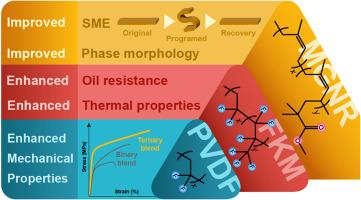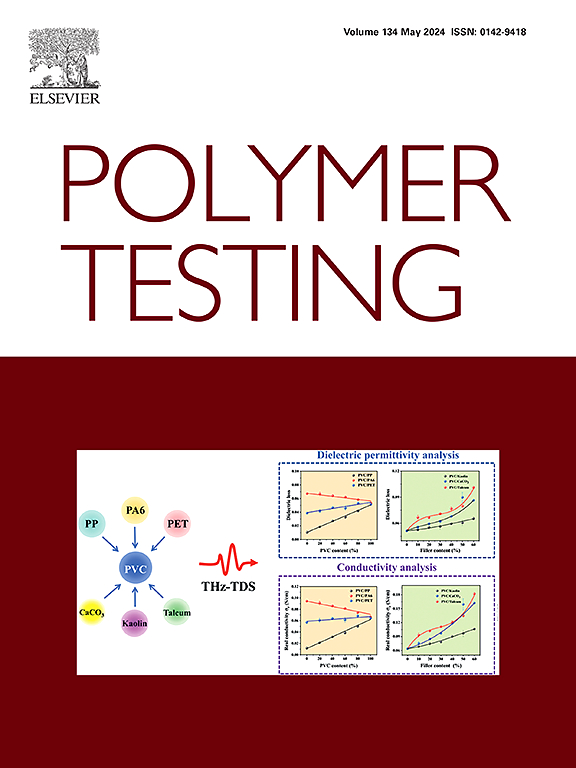A new strategy applying ternary blends of modified natural rubber with fluoroplastic and fluorocarbon elastomer for high-performance thermoplastic vulcanizate
IF 5
2区 材料科学
Q1 MATERIALS SCIENCE, CHARACTERIZATION & TESTING
引用次数: 0
Abstract
High-performance thermoplastic vulcanizates (TPVs) are a class of specialty polymers with exceptional mechanical properties, rubber-like elasticity, excellent processability and recyclability, and an excellent price-performance ratio that make them ideal for a variety of industrial applications. In this work, a successful method of creating high-performance TPV using a ternary blend of poly(methyl methacrylate) modified natural rubber (MGNR), poly(vinylidene fluoride) (PVDF), and fluorocarbon elastomer (FKM) was employed. Combining NR known for its exceptional rubber elasticity and resilience, with fluoropolymers, known for their exceptional chemical resistance and thermal stability, resulted in materials with a synergistic blend of properties. The developed PVDF/FKM/MGNR blend showed higher elasticity, tensile strength, and elongation at break than PVDF/FKM and PVDF/MGNR blends because the ternary blend had greatly improved phase morphology and compatibility between the three phases. The domain size in the ternary blend was smaller than 150 nm. The ternary blends also exhibited excellent thermal properties, where melting and crystallization temperatures were reduced significantly with MGNR due to possible dipole-dipole interactions. At the same time, the oil resistance and shape memory behavior of PVDF/FKM/MGNR were improved at an appropriate blend ratio. The ternary TPVs demonstrated good shape fixities (90–100 %) and shape recoveries (70–80 %). This research offers valuable insights into the design of high-performance thermoplastic elastomers based on natural rubber, which have excellent mechanical properties, solvent resistance, and potential for intelligent and lightweight application.

将改性天然橡胶与氟塑料和碳氟化合物弹性体的三元共混物应用于高性能热塑性硫化弹性体的新策略
高性能热塑性硫化弹性体(TPV)是一类特种聚合物,具有优异的机械性能、类似橡胶的弹性、出色的可加工性和可回收性,以及出色的性价比,是各种工业应用的理想选择。在这项工作中,采用了一种成功的方法,利用聚(甲基丙烯酸甲酯)改性天然橡胶(MGNR)、聚偏氟乙烯(PVDF)和碳氟化合物弹性体(FKM)的三元共混物制造高性能热塑性硫化弹性体。天然橡胶以其优异的橡胶弹性和回弹性著称,而含氟聚合物则以其优异的耐化学性和热稳定性著称,两者的结合使材料具有协同混合的特性。与 PVDF/FKM 和 PVDF/MGNR 混合物相比,所开发的 PVDF/FKM/MGNR 混合物具有更高的弹性、拉伸强度和断裂伸长率,这是因为三元共混物大大改善了三相之间的相形态和相容性。三元共混物中的畴尺寸小于 150 nm。三元共混物还具有优异的热性能,由于可能存在偶极-偶极相互作用,MGNR 的熔化和结晶温度显著降低。同时,在适当的混合比例下,PVDF/FKM/MGNR 的耐油性和形状记忆性能也得到了改善。三元热塑性硫化弹性体具有良好的形状固定性(90%-100%)和形状恢复性(70%-80%)。这项研究为基于天然橡胶的高性能热塑性弹性体的设计提供了宝贵的见解,这种弹性体具有优异的机械性能、耐溶剂性以及智能化和轻质应用的潜力。
本文章由计算机程序翻译,如有差异,请以英文原文为准。
求助全文
约1分钟内获得全文
求助全文
来源期刊

Polymer Testing
工程技术-材料科学:表征与测试
CiteScore
10.70
自引率
5.90%
发文量
328
审稿时长
44 days
期刊介绍:
Polymer Testing focuses on the testing, analysis and characterization of polymer materials, including both synthetic and natural or biobased polymers. Novel testing methods and the testing of novel polymeric materials in bulk, solution and dispersion is covered. In addition, we welcome the submission of the testing of polymeric materials for a wide range of applications and industrial products as well as nanoscale characterization.
The scope includes but is not limited to the following main topics:
Novel testing methods and Chemical analysis
• mechanical, thermal, electrical, chemical, imaging, spectroscopy, scattering and rheology
Physical properties and behaviour of novel polymer systems
• nanoscale properties, morphology, transport properties
Degradation and recycling of polymeric materials when combined with novel testing or characterization methods
• degradation, biodegradation, ageing and fire retardancy
Modelling and Simulation work will be only considered when it is linked to new or previously published experimental results.
 求助内容:
求助内容: 应助结果提醒方式:
应助结果提醒方式:


